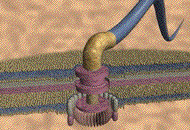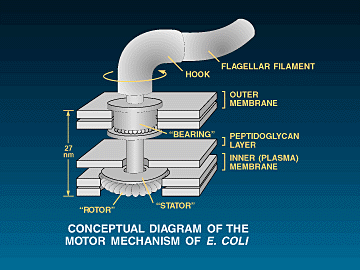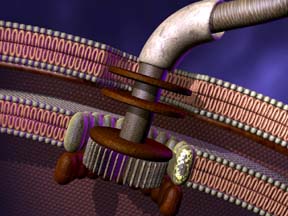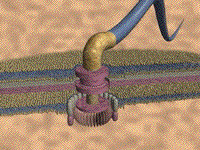 |
Evangelical Service Documentatión / Information Molecular Machines Museum |
|||||||||| Apartado 126 - 08200 SABADELL (Barcelona) ESPAÑA | SPAIN ||||||||
|
|
|
|
The bacterial flagellum is an example of what Michael Behe describes as an irreducibly complex system. In his book, Darwin's Black Box, he explains that such irreducibly complex systems could not have arisen by a gradual step-by-step Darwinian process |
|
Because the bacterial flagellum is
necessarily composed of at least three parts -- a paddle,a rotor, and a
motor -- it is irreducibly complex. Gradual evolution of the flagellum,
like the cilium, therefore faces mammoth hurdles. (p.72)
|
|
Behe summarizes the structure of the bacterial flagellum in these terms:
|
|
Because the bacterial flagellum is necessarily composed of at least three parts -- a paddle,a rotor, and a motor -- it is irreducibly complex. Gradual evolution of the flagellum, like the cilium, therefore faces mammoth hurdles. (p.72) |
|
The structure of a flagellum is quite different from that of a cilium. The flagellum is a long, hairlike filament embedded in the cell membrane. The external filament consists of a single type of protein, called "flagellin." The flagellin filament is the paddle surface that contacts the the liquid during swimming. At the end of the flagellin filament near the surface of the cell, there is a bulge in the thickness of the flagellum. It is here that the filament attaches to the rotor drive. The attachment material is comprised of something called "hook protein." The filament of a bacterial flagellum, unlike a cilium, contains no motor protein; if it is broken off, the filament just floats stiffly in the water. Therefore the motor that rotates the filament-propellor must be located somewhere else. Experiments have demonstrated that it is located at the base of the flagellum, where electron microscopy shows several ring structures occur. The rotary nature of the flagellum has clear, unavoidable consequences ... (pp. 70-72) |
|
animation) |
The consequences Behe refers to are inferred by the nature of its irreducibly complex components, the discovery of which undermines a Darwinian explanation of origins. Behe concludes:
Behe concludes that such irreducibly complex systems were ultimately the result of intelligent design. (It should be pointed out that Behe has no objections to the concept of universal common ancestry. His objections to evolution are limited to the rejection of the neo-Darwinian mechanism as a sufficient explanation for the origin of all biological systems.) |
Copyright ©
1998 Michael J. Behe. All rights reserved. International copyright
secured.
File Date: 6.10.98
[ Previous Page ] [ SEDIN main page ] [SEDIN English index ]
[ Molecular Machines Home ] [ Molecular Machines Index ] [ ARN Home Page ]
This data file may be reproduced in its
entirety for non-commercial use.
A return link to the Access Research Network web site would be
appreciated.
Page development by Premier Publications
for Access Research Network,
Colorado Springs, Colorado, USA.
SEDIN
Apartado 126
08200 SABADELL
(Barcelona) ESPAÑA
Index:
Homepage
English index
PDF documents
(classified by subjects)
||| General English Index ||| Coordinadora Creacionista ||| Museo de Máquinas Moleculares ||| ||| Libros recomendados ||| orígenes ||| vida cristiana ||| bibliografía general ||| ||| Temas de actualidad ||| Documentos en PDF (clasificados por temas) ||| |









